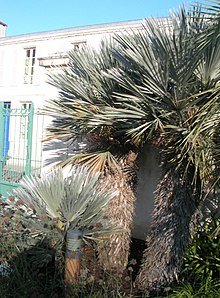Trithrinax
| Trithrinax | |
|---|---|
 |
|
| Trithrinax campestris in a garden, grown as ornamental palm | |
| Scientific classification | |
| Kingdom: | Plantae |
| (unranked): | Angiosperms |
| (unranked): | Monocots |
| (unranked): | Commelinids |
| Order: | Arecales |
| Family: | Arecaceae |
| Subfamily: | Coryphoideae |
| Tribe: | Cryosophileae |
| Genus: | Trithrinax |
| Species | |
|
Trithrinax brasiliensis Mart. |
|
Trithrinax brasiliensis Mart.
Trithrinax campestris (Burmeist.) Drude & Griseb.
Trithrinax schizophylla Drude in Mart.
Trithrinax acanthocoma Drude
Trithrinax is a genus of few flowering plants in the Arecaceae family, that belong to the Coryphoideae subfamily, a not very evolved lineage. The name is derived of ancient Greek, where tri means three, and thrinax trident. It was named as such in 1837 by Carl Friedrich Philipp von Martius a German botanist and explorer.
Trithrinax species are quite spiny fan palms native to South America. They are also resistant to cold, heat, wind, drought, poor soils and other adverse environmental conditions. They germinate fast but their growth is distinctively slow.
Common features of any Trithrinax specimen are:
In the first edition of Genera Palmarum (1987), Natalie Uhl and John Dransfield placed the genus Trithrinax in the subfamily Coryphoideae, the tribe Corypheae and the subtribe Thrinacinae Subsequent phylogenetic analysis showed that the Old World and New World members of the Thrinacinae are not closely related. As a consequence of this, Trithrinax and related genera have been placed in their own tribe, Cryosophileae.
...
Wikipedia
